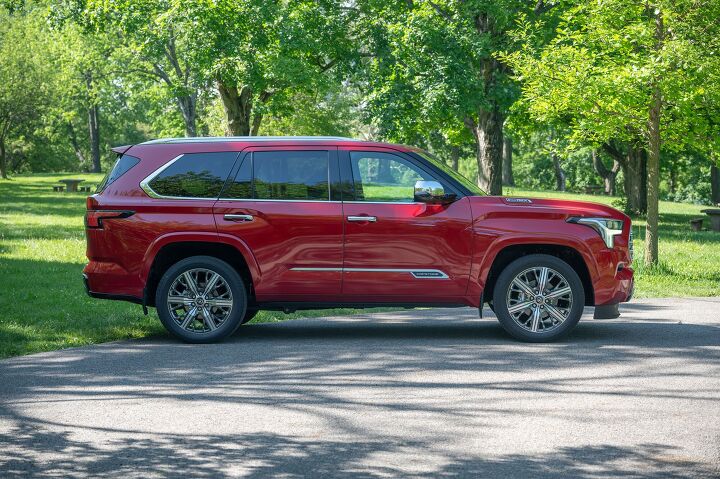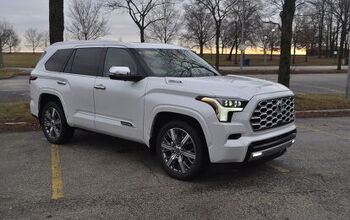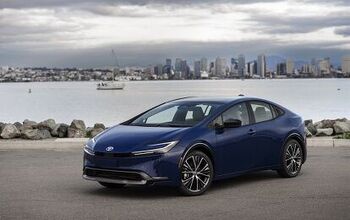2023 Toyota Sequoia Review - A Three-Row Prius?

2023 Toyota Sequoia Capstone 4WD
Toyota wasn’t the first to market a hybrid car here in the U.S. Despite that, the Prius has become the defining hybrid car of the past two decades or so, with the model name occasionally outshining the marque itself. Hybridization has metastasized throughout the Toyota lineup, punctuating nearly every model and segment with electrification.
It only stands to reason that the largest vehicles in a lineup, those vehicles for which fuel economy has never been the sole focus, should be among the last to see battery power. Within full-sized trucks and SUVs, however, there are plenty of gains to be made and plenty of room to stow extra batteries for additional economy and performance.
While the full-sized Tundra offers the choice between a standard turbo V-6 and hybridization, this 2023 Toyota Sequoia is hybrid only. How does it stack up in the real world? Is it a revelation in fuel efficiency, or does it keep you from seeing the redwood forest for the trees?
Whenever I drive a new vehicle, I try to look at it from a few angles. First, I ask myself where it might fit in my life and my driveway. But then I try and consider who the ideal buyer is, and ask how well it fits the needs of that buyer. Maybe it’s all the time I spent in sales, but I know that the marketing and planning departments always have that mythical target buyer in mind when they start to develop a new product.
Perhaps I’m a partial fit for the target demographic of the Sequoia, but I don’t specifically have a need for the size of this thing. When fitted with four-wheel drive, every trim level inches past the magical three-ton mark when empty. It’s 208.1 inches long and 79.6 inches wide, with a 122.0-inch wheelbase. I don’t tow anything regularly, but for those who do, the Sequoia can drag 8,980 pounds of boat, horse, car, or whatever.
For those who do need the capability of this big rig, it’s competitive. The 583 lb-ft of electrically-assisted torque is addictive. Sadly, dipping into the throttle does send the fuel economy reading south, as the 20 mpg combined estimate might be a bit optimistic. My time in the Sequoia yielded readings in the 17 mpg range. That’s no improvement upon what I typically experience in V8-powered domestic rivals. Maybe the big 22-inch wheels fitted to this top-level Capstone trim affect the economy somewhat, though there is no difference in the EPA ratings for lesser trims.
Comfort and ride quality aren’t what one might hope for out of a dreadnought-class SUV, either. Competitors have broadly moved to the independent rear suspension, but the Sequoia persists with the live rear axle borrowed from platform mate Tundra. Midcorner bumps send the hindquarters in a mild shimmy - it’s never uncontrollable, but it isn’t as plush a ride as one finds elsewhere.
The combination of a live axle and hybridization has another downside - rear headroom. The battery is above that axle, and thus right below the third-row seat. While this is a vehicle seemingly meant for hauling mass quantities of human cargo, those of average height and above will find themselves intimately acquainted with the texture of the headliner should they be unlucky enough to pull the short straw boarding position. Materials throughout the interior are quite nice, but that rear row is just a bit too cozy.
My concern with Toyota is they don’t seem to want to be the best with their mainstream vehicles - and that I’m talking about an eighty-thousand-dollar full-size luxury SUV as a mainstream vehicle is frankly absurd, to be honest. It feels as if Toyota is content to let their legendary customer loyalty and fabled reliability continue to feed customers into their showrooms, rather than building fully-realized market-leading vehicles. We know that Toyota has enthusiasts squirreled away within the engineering and product planning teams - witness the crazy GR Corolla I reviewed last month - but it often feels they deliberately hold back on their volume models.
The 2023 Toyota Sequoia is, frankly, more of the same. I have no doubts that they’ll easily sell every one they make. But competitors are building SUVs with fewer compromises, and that’s why I’m disappointed with Toyota’s biggest tree.
[Images: © 2023 Chris Tonn/TTAC.com]
Become a TTAC insider. Get the latest news, features, TTAC takes, and everything else that gets to the truth about cars first by subscribing to our newsletter.

Some enthusiasts say they were born with gasoline in their veins. Chris Tonn, on the other hand, had rust flakes in his eyes nearly since birth. Living in salty Ohio and being hopelessly addicted to vintage British and Japanese steel will do that to you. His work has appeared in eBay Motors, Hagerty, The Truth About Cars, Reader's Digest, AutoGuide, Family Handyman, and Jalopnik. He is a member of the Midwest Automotive Media Association, and he's currently looking for the safety glasses he just set down somewhere.
More by Chris Tonn
Latest Car Reviews
Read moreLatest Product Reviews
Read moreRecent Comments
- NJRide My mom had the 2005 Ford 500. The sitting higher appealed to her coming out of SUVs and vans (this was sort of during a flattening of the move to non-traditional cars) It was packaged well, more room than 90s Taurus/GM H-Bodies for sure. I do remember the CVT was a little buzzy. I wonder if these would have done better if gas hadn't spiked these and the Chrysler 300 seemed to want to revive US full-size sedans. Wonder what percent of these are still on the road.
- 28-Cars-Later Mileage of 29/32/30 is pretty pitiful given the price point and powertrain sorcery to be a "hybrid". What exactly is this supposed to be?
- MRF 95 T-Bird I own a 2018 Challenger GT awd in the same slate gray color. Paid $28k for it in late 2019 as a leftover on the lot. It’s probably worth $23k today which is roughly what this 2015 RT should be going for.
- Mike978 There is trouble recruiting police because they know they won’t get support from local (Democratic) mayors if the arrests are on favored groups.
- FreedMike I'm sure that someone in the U.S. commerce department during the 1950s said, "you know, that whole computer thing is gonna be big, and some country is going to cash in...might as well be us. How do we kick start this?" Thus began billions of taxpayer dollars being spent to develop computers, and then the Internet. And - voila! - now we have a world-leading computer industry that's generated untold trillions of dollars of value for the the good old US of A. Would "the market" have eventually developed it? Of course. The question is how much later it would have done so and how much lead time (and capital) we would have ceded to other countries. We can do the same for alternative energy, electric vehicles, and fusion power. That stuff is all coming, it's going to be huge, and someone's gonna cash in. If it's not us, you can damn well bet it'll be China or the EU (and don't count out India). If that's not what you want, then stop grumbling about the big bad gubmint spending money on all that stuff (and no doubt doing said grumbling on the computer and the Internet that were developed in the first place because the big bad gubmint spent money to develop them).











































Comments
Join the conversation
Jumping in here to address the comments about 'the Sequoia persists with the live rear axle borrowed from platform mate Tundra'. Previous gen Sequoia actually went IRS for the 2008 MY straight through to 2022 MY.
I suspect they saw Ford go IRS in the Expedition in 2003 or 2004 and were quick to copy them. Then they saw GM stay with solid axle (and dominate the market) for another decade and decide it wasn't worth the added cost / complexity. Of course GM just went IRS, a couple of years ago, so we will have to wait another 15 year Sequoia product cycle to see if Toyota follows suit :)!
80K for a Toyota that is not named Land Cruiser...